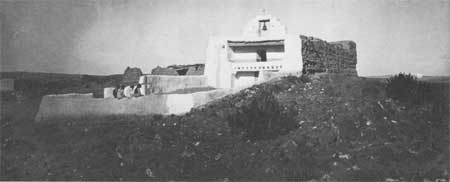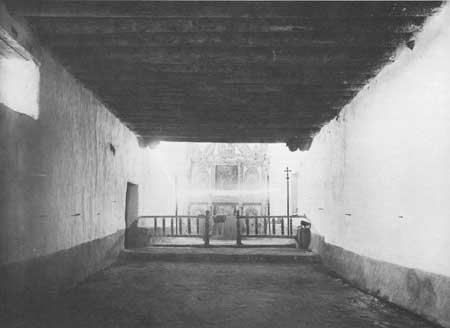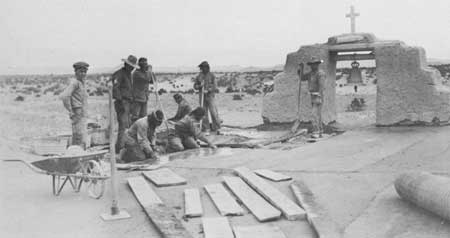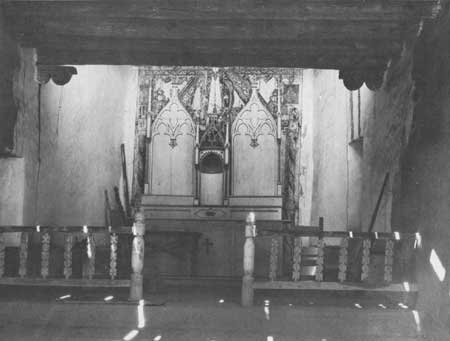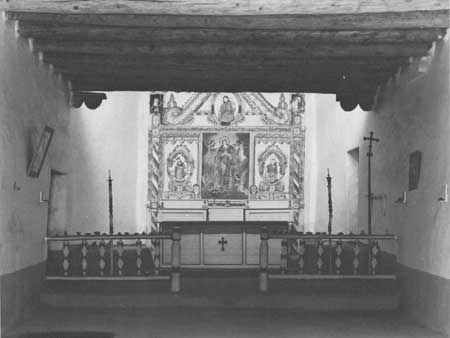

|
Zia "The church is large," Adolph Bandelier wrote in 1888, "and the outer walls are asserted to be those of the church prior to 1680, the new walls being built inside of them. The appearance justifies the presumption of old age." Still, he was skeptical. "The site may be the same," he decided in his Final Report, "but the church is probably a more recent edifice, though possibly erected on the old foundations." [1] One reason the Zia church looked so old was its doubly thick south wall, the result, says tradition, of an undated miscalculation. The men of the pueblo, it seemed, had hauled vigas down from the mountains to reroof the church. Somehow they had cut them too short, and after the wood had cured, these beams would no longer span the required distance. Rather than cut new ones, drag them down, and wait for them to cure, the Indians simply widened the south wall inside until the vigas at hand fit properly. Although not all archaeologists agree, it would appear that the Keresan-speaking pueblo of Nuestra Señora de la Asunción de Zia occupied the same site after the Revolt of 1680 as before, atop a sterile-looking little mesa strewn with chunks of the black basalt used here along with adobe for building. To get to the pueblo one journeyed 16 miles up the Jémez from the Rio Grande. Savagely assaulted in 1689 by Governor Domingo Jironza Petris de Cruzate, a Spaniard desperate for great deeds to lay before his king, Zia fell. Several hundred of its inhabitants were reported killed, likely an inflated figure, and the pueblo was thoroughly sacked. Three years later Diego de Vargas found the people living 10 miles north. They were eager to cooperate. "I ordered them to reoccupy their said pueblo," Vargas recorded in his journal, "since the walls are strong and in good condition, and also the nave and main altar of the church are in good condition, only lacking the wooden parts, which I ordered them to cut at the time of the next moon." [2] Fray Juan Alpuente, installed at Zia on September 27, 1694, stayed only long enough to improvise a temporary chapel, probably somewhere in the pre-Revolt convento. In 1706 Custos Juan Álvarez claimed that the church under construction "is now at a good height." It may have used the standing pre-1680 walls, or at least the foundations. Fray Manuel Bermejo, serving Zia in 1750, asked rhetorically why certain government officials did not commend the friars for building churches and conventos, "working personally with the Indians themselves, without the help of said gentlemen, as I am doing at present on the church that I have begun from the foundation up and on the repair of the convento which was falling to ruin." [3] Either Father Domínguez was confused about the builder of the Zia church he inspected in 1776, or else Bermejo, despite his bluster, had not finished the job before he left in 1752. Domínguez credited Bermejo's successor, Fray Francisco Javier Dávila, with having built the structure. Whoever did, it stood well off from the main cluster of house blocks, another clue that it occupied the same site it had in the seventeenth century when the pueblo was larger and less submissive. Its flat, unrelieved facade looked toward the rising sun. Nave and sanctuary inside, long and gallerylike but unusually well lighted by clerestory and four windows on the Gospel side, measured together between 110 and 120 feet. At some later date, undocumented at present, the roof was lowered and the facade was set back, shortening the nave by over 30 feet and leaving a portion of the walls projecting forward to create a sort of open narthex with balcony. [4]
In 1798, the year Antonio José Ortiz commissioned the Laguna santero to fashion an altar screen for Santa Fe's San Miguel church, don Victor Sandoval and doña Maria Manuela Ortiz, his wife, arranged with the same artist to do likewise at Zia. Of carved and painted wood, with characteristic twisted columns, it filled the entire west wall behind the altar. The old canvas of the Assumption of Our Lady hung in the center with two oval paintings on each side. A pious gesture on the part of its donors, the new altar screen did not reflect prosperity at Zia. Fray Mariano José Sánchez Vergara, listing it matter of factly in 1806, appended a note to his inventory. "This is all that this church possesses, and everything is in need of repair. To do so there are no settlers and no funds to tap. Unless some measure is taken for this purpose nothing will improve." [5]
In the opinion of Lieutenant Bourke, who was hospitably received in 1881, "Zia, altho' one of the smallest pueblos, is one of the most interesting to the student and traveller."
Because of its antiquity and the extreme deterioration of its "muy viejo" roof, open to the sky in places, the church at Zia became in 1923 the first major objective of the Committee for the Preservation and Restoration of the New Mexican Mission Churches. President William B. Storey of the Santa Fe Railroad, William P. McPhee of Denver, and a number of others contributed funds. Architect Burnham Hoyt made an inspection in mid-October, materials were ordered, and Zia crews began removing dirt and rotted boards before the end of the month. Odd S. Halseth, a staff member at the Museum of New Mexico, and Santa Fe artist Jozef G. Bakos oversaw the job. First they replaced three suspect vigas. New boards went on, followed by roofing paper, dirt, heavy copper-lined canales, two inches of concrete and chicken wire, special elaterite roofing paper, asphalt, a new parapet, and tons more dirt. In the final stage "the whole pueblo took part, women and men, the latter carrying the dirt to the younger men, who passed it up ladders to the roof, and in one day two inches of dirt over the entire roof belied the modern." By December 8, 1923, at least one New Mexico mission church was leakproof. [7]
In the course of reroofing the top portion of an early twentieth-century neo-Gothic altar screen "of rustic Viollet Le Duc trumpery" was taken down, revealing the older work hidden behind it. Although Father Bernard Espelage, the Franciscan from Jémez who ministered at Zia, took the discovery for part "primitive French and part Spanish," a photograph by Halseth allowed colonial art expert E. Boyd many years later to identify it as genuine Laguna santero. Meantime, about 1930, Zia artist Andrés Galván had overpainted the screen with four images, copying the Assumption from the old painting. His floral and scallop embellishments even Boyd had to admit were "not ably well designed." [8] Were Adolph Bandelier to attend services at Zia in the 1970s, he might still comment on the packed earth floor and the absence of pews. But he would be more comfortable. Today modern gas heating panels hang from the vigas, and on each of the freshly stuccoed long walls of the nave, below the Stations of the Cross and above the candle sconces, are three small electric light fixtures. Outside, the convento is gone. The church's deep-set white facade still looks out on the walled but unused cemetery. The rest of the building has been coated recently with a light golden stucco, setting it off dramatically. All is in good repair. Yet the modern does not dominate. After a careful inspection Bandelier would have to agree: the mission of Nuestra Señora de la Asunción de Zia still "justifies the presumption of old age."
Copyright © 1980 by the University of New Mexico Press. All rights reserved. Material from this edition published for the Cultural Properties Review Committee by the University of New Mexico Press may not be reproduced in any manner without the written consent of the author and the University of New Mexico Press. | ||||||||||||
 Top Top
|
| ||||||||||||

